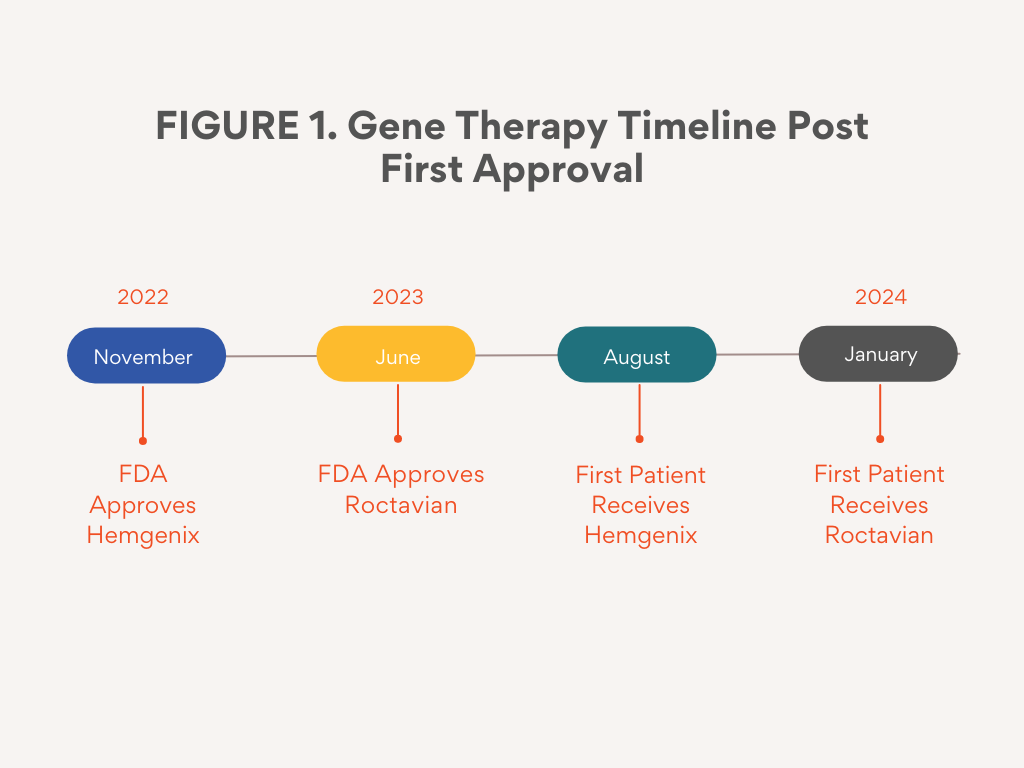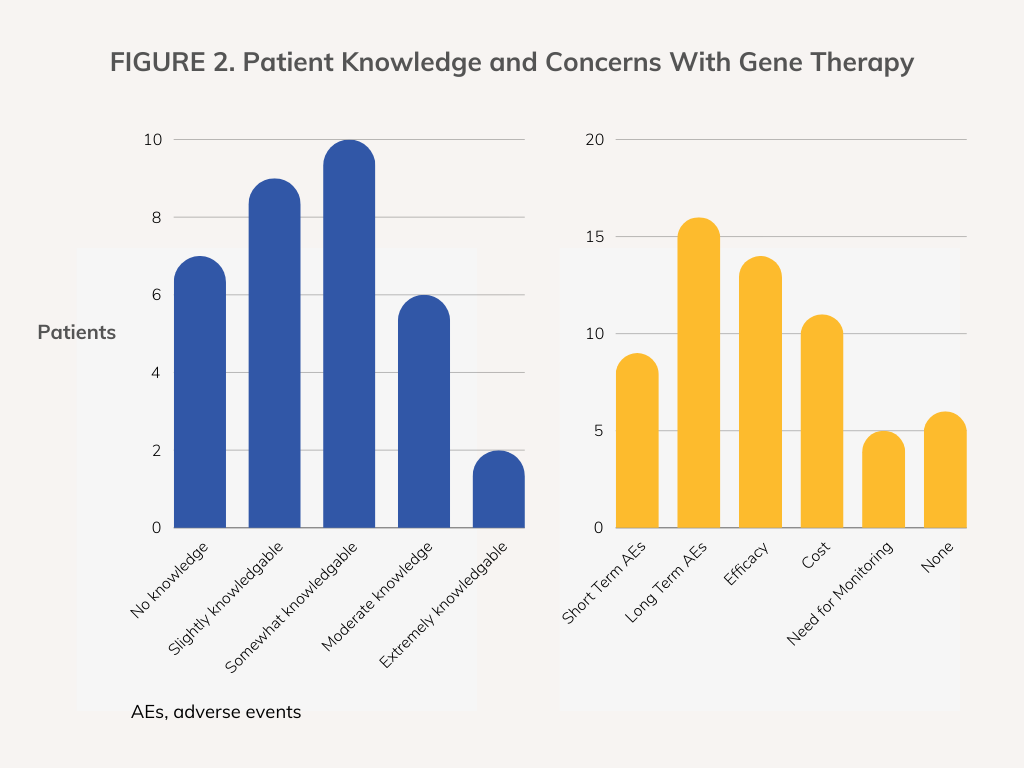A Slow Embrace: Hemophilia's Gradual Adoption of Gene Therapy
For World Hemophilia Day, CGTLive takes a look at how the hemophilia field has adapted to the introduction of gene therapy to the treatment landscape.
The treatment landscape for patients with hemophilia has been enriched with one-time gene therapies, as of the November 2022 United States (US) approval of etranacogene dezaparvovec and the June 2023 US approval of valoctocogene roxaparvovec, both adeno associated virus (AAV) vector gene therapies.1,2
UniQure and CSL Behring’s etranacogene dezaparvovec, marketed as Hemgenix, is approved for treating adults with hemophilia B who currently use Factor IX (FIX) prophylaxis therapy, have current or historical life-threatening hemorrhage, or have repeated, serious spontaneous bleeding episodes. BioMarin’s valoctocogene roxaparvovec, marketed as Roctavian, is approved for the treatment of adults with severe hemophilia A defined as congenital factor VIII (FVIII) deficiency with FVIII activity of less than 1 IU/dL who do not have antibodies to adeno-associated virus serotype 5 (AAV5) according to an FDA-approved test.
Click to enlarge

A Slow Uptake
Although Hemgenix was approved over 1.5 years ago and Roctavian was approved over 6 months ago, the first patients outside of clinical trials only started to receive the gene therapies over 6 months after their approvals – with the first patient just receiving Roctavian in December 2023 at the Center for Inherited Bleeding Disorders, California.3,4 (FIGURE 1)
“We and the patient are very pleased with the results," Amit Soni, MD, pediatric hematology, Children’s Hospital of Orange County, and medical director, Center for Inherited Bleeding Disorders (CIBD), told CGTLive®. "I think by having more stories like ours get out in the community, that will further build confidence in the treatment so more patients and providers feel comfortable adopting this type of therapy."
While a new chapter is certainly ahead for the treatment field of hemophilia, it is unclear just how long it will take to fully turn the page. Beginning with the earlier Hemgenix approval, hemophilia treatment center sites have had to sort through the logistics of bringing gene therapy administration out of a clinical trial setting and into a real-world setting for, potentially, a much wider pool of patients with hemophilia.
Steven W. Pipe, MD

“We haven't seen a lot of patients dosed yet. And I don't think that’s related to either the enthusiasm of the clinicians or the patients, but really just the mechanics of how to deliver this in the clinical space, as opposed to the research trials... We've seen that a lot of the hemophilia treatment center sites have got their components together, their infrastructure and personnel so that they can actually start delivering this in the commercial setting. And so, I'm really looking forward to seeing this making a difference in patients' lives in a real world setting," Steven W. Pipe, MD, professor of pediatric hematology/oncology, CS Mott Children’s Hospital, told CGTLive. Pipe has served as an investigator on both the pivotal phase 3 GENEr8-1 (NCT03370913) and HOPE-B (NCT03569891) trials evaluating Roctavian and Hemgenix, respectively.
Adam Cuker, MD
Credit: Penn Medicine

“It's extremely expensive. And I think that it's going to take some time to be able to convince payers to cover this product. And then secondly, what I'm learning at my own institution is that there's a lot of infrastructure that needs to be built out at the institutional level, in order to be a gene therapy infusion center. You know, we served as a center in investigational trials... but it's a different beast when you're dosing post approval. We're working on that, and it's being done in many other institutions,” Adam Cuker, MD, associate professor of medicine, University of Pennsylvania, previously told CGTLive.
"It does take a committed patient to do gene therapy knowing that they're going to get frequent lab draws, and we monitor the lab draw so look for any complications that may follow. Many of the patients have done well on this therapy, hence it's FDA approved," Soni said. "Another challenge we've had is getting insurance approval, there is a authorization process. But as we start to do more gene therapies, that's still a barrier, but less of a barrier now than it was even a year ago."
Gene Therapy in Unstudied Populations
Opening gene therapy to a new, wider pool of patients also raises questions about how these therapies may work in patients with various comorbidities for which there is no established dataset.
Research on Hemgenix presented at the 2023 American Society of Hematology (ASH) Annual Meeting & Exposition, held December 9-12, in San Diego, California attempted to address some of these questions with data on a few patients with comorbid HIV or chronic hepatitis C virus or hepatitis B virus (HCBV+) without active viral disease from the HOPE-B trial and a phase 2b clinical trial (NCT03489291). Overall, investigators observed similar safety and efficacy characteristics in these patients compared with those without the comorbidities, with similar improvements in annualized bleeding rate and FIX activity and similar incidences of adverse events.5,6
“What we can say from evaluation of these comorbidities is they seem to have no difference in the overall safety profile, and no perceived difference in the efficacy readouts either. So, I think this is important for patients and for clinicians to know that this profile of patient doesn't have to be excluded from receiving this particular product,” Pipe said.
The data, while limited, may assuage some concerns about gene therapy’s suitability for patients with comorbidities of HIV and HCBV+. However, there is a larger group of patients who currently do not have approved access to gene therapy for their hemophilia – pediatric patients for which liver-directed AAV therapy may lead to complications in a growing body. Pipe believes that gene therapy can be shown to be safe and effective in this population and improve outcomes by addressing hemophilia earlier in life.
"I'm very excited about the option of potentially moving this down into the adolescent age group. This liver directed AAV median therapy should work in a relatively mature liver. I think most of the data would support that livers are mostly adult size and behavior as far as cellular turnover, up to about age 12 or 13. So, I think you're going to see quite soon, some clinical trials opening up that will take this platform of therapy and go down into the 16 and 17 year olds, and then maybe even 14 and 15 year olds. And I think that's great, because the earlier that we can get definitive control, we're going to have a significant impact on not just quality of life parameters, but potentially also on joint outcomes over the long term,” Pipe said.
Click to enlarge

Informed Consent and Continued Questions on Durability
Bringing gene therapy into the treatment landscape also requires a close look at the informed consent process for patients to fully understand the risks and limitations of Hemgenix and Roctavian, if they are unsatisfied with current standard of care enzyme replacement therapy (ERT) and want to consider gene therapy. While gene therapy may offer a one-time treatment to durably restore FVIII or FIX expression as an alternative to regular ERT infusions, many patients are hesitant toward, and clinicians hesitant to recommend, the first generation AAV therapies.
Not only do questions still remain about the durability of gene therapy, which seems to be higher for hemophilia B than hemophilia A (94% vs 92% remained off ERT at 3 years, although FVIII/FIX expression fell in all patients), but receiving a first-generation therapy would also void the possibility any potential future AAV products due to antibody formation.7,8
Recent research was unable to identify predictors of loss of response or return to prophylaxis in a small subset of patients after gene therapy, albeit for Pfizer’s fidanacogene elaparvovec, a different AAV gene therapy candidate for hemophilia B.9 On the other hand, research on Roctavian found that patients with low levels of transgene-derived endogenous FVIII expression still derived hemostatic protective benefits from the therapy, with improved ABR from baseline.10
“It's a really interesting question about why the gene therapy appears to be durable in this case, and with other some other gene therapy products, for example, for hemophilia A, the response may be less durable. And I'll be honest, I don't think that we understand the answer to that question. There are a number of theories, but nothing proven as yet. I think we need a lot more research to try to understand that,” Cuker said.
Understandably, patients may want more than protective benefits from a supposed “one and done” treatment. Findings from a recent survey found that patients with hemophilia are content with their current treatment regimens and only a minority are currently eager to undergo gene therapy. Most patients did not consider themselves knowledgeable about gene therapy and cited chief concerns of safety, efficacy, and cost.11 Along with patients, providers have also identified a need for more guidance in helping patients make decisions about their treatment. (FIGURE 2)
While the field may still be adapting to fully bring gene therapy into the fold, fortunately research continues to bring better therapies, gene therapy and more traditional therapies, to patients with hemophilia.
“Gene therapy is not going to ever be suitable or even an option for every patient. We should continue to see evolution in new recombinant based therapies, new nonfactor therapies, and maybe even approaches that people haven't really even conceived to this point,” Pipe said. “I think this is great that the whole space remains very active, and ultimately, it's going to benefit all of our patients.”